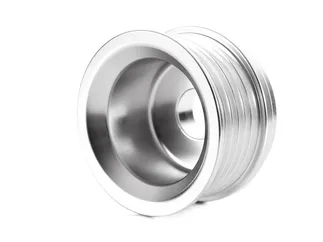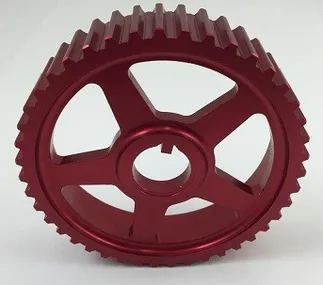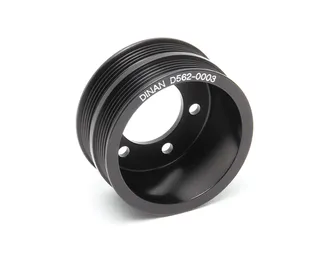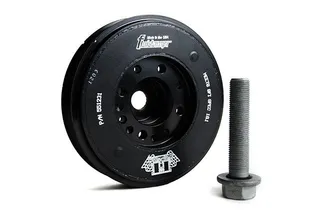Product Information
Group Buy - Limited to 15 pulleys
The Fluidampr replaces your crank pulley to control the harmonics through all RPM ranges of your engine. The precision machined and balanced internal inertia ring inside the precision machined and balanced housing is constantly shearing through the silicone while the engine is turning, tuning to the harmonic frequency bandwidths that your engine is producing real time. Rubber (elastomeric) dampers are only tuned for a specific narrow bandwidth of harmonics and they cannot tune up or down to what your engine is producing. They also wear out and have to be rebuilt or re-tuned frequently. Our Fluidampr products never wear out or have to be re-tuned, as they are constantly balancing the engine to max efficiency via the internal inertia ring. Fluidampr also helps to calm down the chatter associated with double disc clutches.
Benefits of the Fluidampr
-- Decreased engine vibration. No more flywheels, crank trigger wheels, or timing gears falling off of the crankshaft. This is unavoidable when revving past 8000rpm without an engine damper.
-- Decreased "Clutch/Gear Box Chatter" which is caused by lightweight single mass flywheels.
-- Reduction in rpm drops when shifting in a competitive environment.
-- Gains of 3-10whp and 5-13ft/lbs. torque depending on your current setup.
-- An overall more efficient and reliable engine.
Check out this detailed diagram breakdown of how the Fluidampr works!
Let’s talk about rubber
Other dampers on the market use rubber or “elastomer” as the insulator for the internal flywheel. Rubber deteriorates and wears down from repeated movements. In layman’s terms, the more you work it, the weaker it will get. The inertia ring that balances an elastomeric damper becomes unstable when the o-rings start to wear. Think of it this way, what does a car wheel feel like when it looses one of its balancing weights? How would a fan missing a blade function? A damper with worn o-rings can unbalance a crankshaft and destroy it. The reason car manufactures install elastomer dampers at the factory is not for performance but for cost. The “rubber” dampers are cheaper and easier to make.
Click here for dyno test results and graphs
Quality
Fluidampr's are SFI 18.1 approved!! SFI 18.1 stands for harmonic balancer construction quality. Having a damper let loose on a race track is a serious safety matter. Section 18.1 refers to Crankshaft Hub Harmonic Dampers. Article 3.0 Construction, dictates that “the damper shall be constructed in such a manner that the inertia devices shall not become disengaged during use… For inertia disc style dampers, the containment device must cover a minimum of 50 percent of the cavity containing the disc. The thickness of the containment material must be a minimum of 0.062 inch steel or 0.180 inch aluminum.” Article 5.1.3 B Testing Procedure mandates that “The damper shall be driven to a rotational speed between 12,500 and 13,500 rpm and maintained at that level for one hour.” Furthermore, the steel of a SFI certified Fluidampr housing must meet a minimum 40,000psi yield strength and 60,000psi tensile strength under testing.






